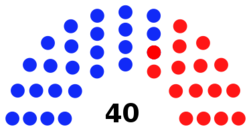
Back مجلس شيوخ نيوجيرسي Arabic Senáu de Nueva Jersey AST Senat von New Jersey German Senado de Nueva Jersey Spanish Sénat du New Jersey French הסנאט של ניו ג'רזי HE Senato del New Jersey Italian ニュージャージー州議会元老院 Japanese New Jersey Senate SIMPLE New Jerseys senat Swedish
New Jersey Senate | |
|---|---|
| New Jersey Legislature | |
 | |
| Type | |
| Type | |
Term limits | None |
| History | |
New session started | January 9, 2024 |
| Leadership | |
President | |
President pro tempore | |
Majority Leader | |
Deputy Majority Leader | |
Minority Leader | |
| Structure | |
| Seats | 40 |
 | |
Political groups | Majority
Minority
|
Length of term | 4 years (with one two-year term each decade) |
| Authority | Article IV, New Jersey Constitution |
| Salary | $49,000/year |
| Elections | |
Last election | November 7, 2023 |
Next election | November 2, 2027 |
| Redistricting | New Jersey Apportionment Commission |
| Meeting place | |
 | |
| State Senate Chamber New Jersey State House Trenton, New Jersey | |
| Website | |
| New Jersey State Legislature | |
The New Jersey Senate is the upper house of the New Jersey Legislature by the Constitution of 1844, replacing the Legislative Council. There are 40 legislative districts, representing districts with an average population of 232,225 (2020 figure). Each district has one senator and two members of the New Jersey General Assembly, the lower house of the legislature. Prior to the election in which they are chosen, senators must be a minimum of 30 years old and a resident of the state for four years to be eligible to serve in office.[1]
From 1844 until 1965 (when the Reynolds v. Sims US Supreme Court decision mandated all state legislators be elected from districts of roughly equal population), each county was an electoral district electing one senator. Under the 1844 Constitution, the term of office was three years, which was changed to four years with the 1947 Constitution. Since 1968 the Senate has consisted of 40 senators, who are elected in a 2-4-4 cycle. Senators serve a two-year term at the beginning of each decade, with the rest of the decade divided into two four-year terms. The 2-4-4 cycle was put into place so that Senate elections can reflect the changes made to the district boundaries on the basis of the decennial United States Census.[1] If the cycle were not put into place, then the boundaries would sometimes be four years out of date before being used for Senate elections. Rather, with the varied term, the boundaries are only two years out of date. Thus elections for Senate seats take place in years ending with a 1, 3, or 7 (i.e. next elections in 2027, 2031, and 2033).
Interim appointments are made to fill vacant legislative seats by the county committee or committees of the party of the vacating person (since a constitutional amendment passed on November 8, 1988). The office is on the ballot for the next general election, even if the other Senate seats are not up for election in that year (such as in years ending with a 5 or 9, such as 2009 or 2015). The sole exception to this is if the vacancy occurred within 51 days of the election, in which case the appointment stands until the following general election.[2]
- ^ a b Our Legislature, New Jersey Legislature. Accessed January 10, 2018. "Legislative elections are held in November of each odd-numbered year. Members of the Assembly serve two-year terms. Senators serve four-year terms, except for the first term of a new decade, which is only two years. This '2-4-4' cycle allows for elections from new districts as soon as possible after each reapportionment."
- ^ New Jersey Constitution Archived June 30, 2009, at the Wayback Machine, New Jersey Legislature. Accessed January 10, 2018. "Any vacancy in the Legislature occasioned otherwise than by expiration of term shall be filled by election for the unexpired term only at the next general election occurring not less than 51 days after the occurrence of the vacancy, except that no vacancy shall be filled at the general election which immediately precedes the expiration of the term in which the vacancy occurs. For the interim period pending the election and qualification of a successor to fill the vacancy, or for the remainder of the term in the case of a vacancy occurring that cannot be filled pursuant to the terms of this paragraph at a general election, the vacancy shall be filled within 35 days by the members of the county committee of the political party of which the incumbent was the nominee from the municipalities or districts or units thereof which comprise the legislative district. Article IV, Section IV, paragraph 1 amended effective December 8, 1988."